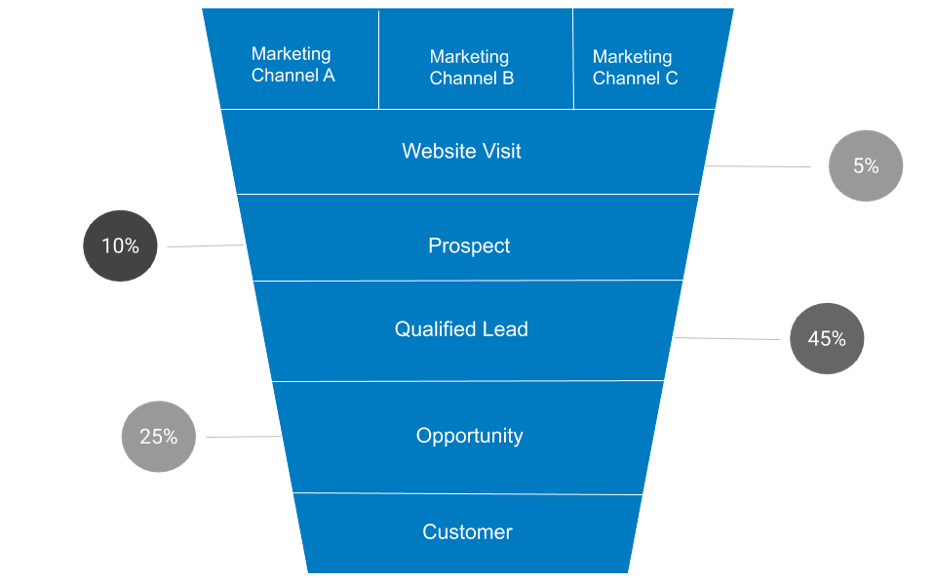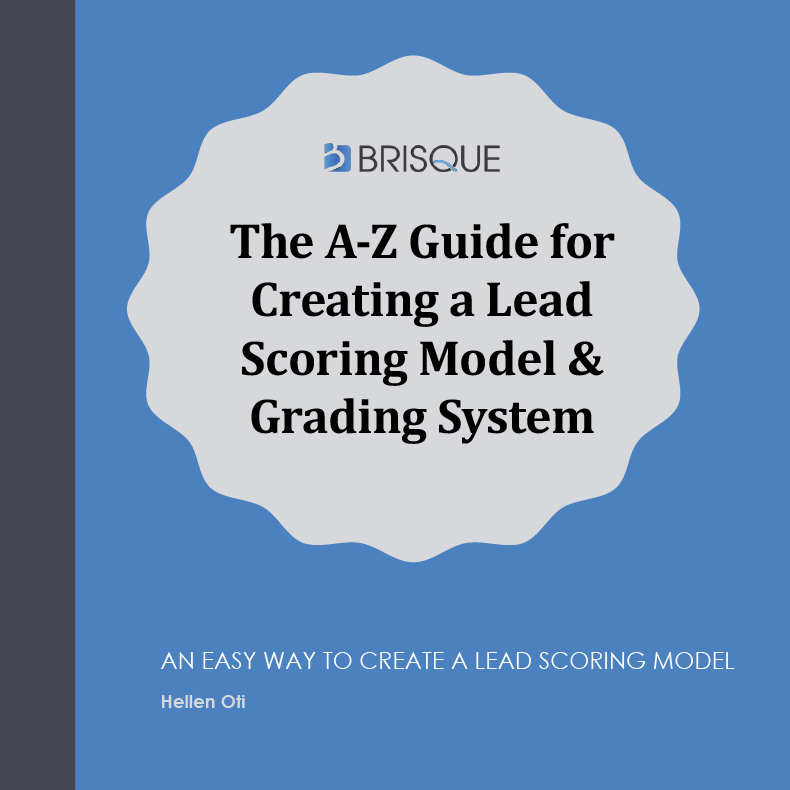Summary
More leads, please!
While at it, make them qualified and with a credit card in hand. The question is, how many?
In this post, we cover how you calculate the number of leads required to meet your sales revenue goals and why it’s critical to use the bottom-up approach when setting your sales goals.
The story continues.
In our last post in the Proving Marketing ROI blog series, we had a hypothetical case of someone using the top-down approach instead of the bottom-up approach to find out what a revenue goal of 50% would look like in terms of new business.
It turned out that for Awesome AI Inc, our fictional business, they would need to increase new sales by 300% or get 100 new deals to meet the 50% revenue increase goal.
Now, we’ll turn our attention to what the sales goal would look like if you work your way down to your sales and marketing activities. How many leads would you need to generate to meet the goal?
A quick note, although we are doing this type of reverse engineering calculation, ideally, you’d want to use a more bottom-up approach to your goal setting.
As a refresher, here are the metrics for Awesome AI Inc.
| Awesome AI Inc: This Year’s Sales Goals |
| · This year’s total growth revenue goal: 50% |
| · Total Goal revenue: $7.5M |
| Revenue Breakdown at 50% increase: |
| · Total revenue (new business): $4.5M |
| · Total revenue (existing customers): $3M |
| Awesome AI Inc: Last Year’s Revenue |
| · Last year’s total revenue: $5M |
| · Last year’s new sales revenue: $3M |
| · Last year’s revenue from existing customers: $2M |
| · Total number of new customers acquired: 25 |
| · Total number of customers (new and existing): 100 |
| · Average new business deal: $50,000 |
| · Last year’s current customer revenue from upgrades: $1.5M |
| · Customer retention rate: 95% |
| · Customer churn rate: 5% |
| · Last year’s existing customer maintenance revenue: $0.5M |
| Awesome AI Inc: Existing Conversion Ratios |
| · Existing customer upgrade conversion rate: 75% |
| · Opportunity to new sale conversion rate: 25% |
| · Lead to opportunity conversion rate: 45% |
| · Prospect to lead conversion rate: 10% |
| · Website visitor to prospect conversion rate: 5% |
|
Awesome AI Inc: Last year’s estimated Conversion Values |
| · Number of new customers: 25 |
| · Number of opportunities: 100 (25% conversion from opportunity to sale) |
| · Number of qualified leads: 223 (45% conversion from qualified lead to opportunity) |
| · Number of prospects: 2230 (10% conversion from prospect to lead) |
| · Number of Website visitors: 44,600 (5% conversion from web visit to prospect) |
How Many Leads Do You Need to Generate to Meet Your Sales Goals?
As stated earlier, in our previous post, we discovered that we’d need to get 100 new deals to reach our 50% revenue increase goal.
Now, we have to reverse engineer to figure out how much attention you’d need to get from potential customers to meet that goal.
In this example, Awesome AI Inc has established conversion rates throughout the marketing and sales cycle. We’ll use those conversion rates to help us estimate how many leads the company would need to generate to meet the set goal.
First, let’s take a look at the company’s marketing lead to sales process to help us better understand the company’s operation.
Figure 1: Awesome AI, Inc. Marketing to Sales Process and Conversion Rates

From what you can see from figure 1 above, Awesome AI Inc has a marketing to sales process that starts with a potential customer visiting their website from a marketing channel.
- For every website visit, 5% of the visitors convert to a prospect by completing a form fill on the site.
- Then, 10% of these prospects are qualified leads. That is people that meet the company’s sales criteria and are ready to be involved in an active sales cycle.
- Out of those qualified leads, the company then has about 45% of them becoming an active opportunity that is pursued by the sales team.
- Then finally, of the current opportunities, the sales team tends to close 25% of the deals, making them customers.
How to Calculate the Number of Leads You Need to Generate
Since we started off calculating how many new deals, we would need to meet our original growth goal of 50%, let’s also take a look at how many qualified leads and opportunities that equates to:
Calculating Number of Opportunity Stage Deals Needed
- Opportunity to customer conversion rate: 25%
- If 100 new deals = 25 %
- Then, 100% = (1/0.25) * 100 = 400 opportunity stage deals
Calculating Number of Qualified Leads Needed
- Qualified lead to opportunity conversion rate: 45%
- If 45% = 400 opportunities
- Then, 100% = (1/0.45) *400 = 888.88 ~ approximately 889 qualified leads
Calculating Number of Qualified Leads Needed Monthly
- 889/12 = 74.08 ~ approximately 74 qualified leads
Calculating Total Number of Prospects Needed
- Prospect to qualified lead conversion rate: 10%
- If 10% = 889 qualified leads
- Then, 100% = (1/0.10) * 889 = 8,890 prospects
Calculating Number of Prospects Needed Monthly
- 8890/12 = 740.83 ~ approximately 741 prospects
Calculating Number of Website Visitors Needed to Get 741 Prospects
- Website visitor to prospect conversion rate: 5%
- If 5% = 8890 prospects
- Then, 100% = (1/0.05) * 8890 = 177,800 website visitors
Calculating Number of Website Visitors Needed Monthly
- 177800/12 = 14816.66 ~ approximately 14,817
Let’s put it into context by comparing this to last year’s numbers.
Figure 2: Awesome AI, Inc. Growth Goals vs. Last Year Actuals
| Sales Cycle Stage | Last Year Actual | New Growth Goal | Percentage Increase |
| Website Visitor | 44,600 | 177800 | 298.65% |
| Prospect | 2230 | 8890 | 298.65% |
| Qualified Lead | 223 | 889 | 298.65% |
| Opportunity | 100 | 400 | 300.00% |
| Customer | 25 | 100 | 300.00% |
As clearly illustrated here, while you may have thought of a 50% growth increase as attainable when looking at the growth number in a vacuum, the details reveal that it is quite an aggressive goal that may not be possible depending on the situation at hand.
The key element to note here is that without clearly analyzing the granular details of what it means to increase growth, you may set up your team for failure.
In our example, with Awesome AI Inc., it’s evident that your lead generation activity would need to change drastically to make a growth goal of 50% possible.
This goal, when analyzed in more detail, means increasing your marketing and sales activity results by 300%.
Essentially, if you’d like to meet the 50% goal, then you’d have to have the necessary resources to back that. In the top-down goal setting, you could also set up multiple scenarios and analyze what each situation could look like.
So, you could answer questions like, what if I tried for 30% or 35% growth, what would that look like?
You could, in the end, come up with a growth number that looks more realistic after looking at the details. The issue here, though is that, you’d have to get all the sales and marketing teams to buy into your top growth goal.
Getting people to buy into your goal is the first step to achieving the goal. This is not even related to how much money you can invest in marketing and sales. It’s about how much effort a team member is likely to put into achieving that goal.
As a result, using the bottom-up approach to goal setting creates a better sense of team buy-in.
Bottom-Up Approach to Goal Setting
As evidenced by our previous analysis of what a 50% growth goal could look like on sales and marketing activities, setting a top-level goal and then having the sales and marketing teams scramble to meet those goals is not always ideal.
More importantly, it has the chance of backfiring with many people that are supposed to buy into your dream and make it a reality, feeling under appreciated, overwhelmed, and very unlikely to meet your goal.
For this reason, I caution against business growth goal-setting processes that take a top-down approach.
At first, this can sound scary because most business leaders feel like they have the vision of where the business should be heading. While this is true, a leader’s role is to determine the vision and direction, and then you have to leave room for others in the business to determine how the company gets there.
What is the Bottom-Up Sales Goal Setting Approach?
The bottom-up sales goal setting approach is when you set your goals starting at the beginning of your sales and marketing process instead of the top (revenue growth). It involves analyzing how much you can increase each marketing channel and optimize conversions, and then you look at what that would look like in sales revenue.
How do you set sales goals using the bottom-up goal-setting method?
In figure 1 above, you can see the Awesome AI Inc.’s marketing to sales process starts with a marketing channel activity. That marketing channel activity will most likely have a manager who is in charge of that channel. You may also have someone who is in charge of managing your website activity, perhaps a business development manager who follows up with prospects after they request information. Then, finally, sales representatives who manage active sales processes from qualified lead to opportunity to customer. You may also have account managers who focus on customer satisfaction and also identify cross-sell opportunities.
In the bottom-up goal-setting approach, you’d let each of them come up with reasonable lead generation goals and then together decide what the top number would be.
Let’s take a look at what that could look like using the Awesome Inc example.
In the example, we didn’t include customer conversion rates for the different channels A, B and C. So, let’s take a look at that now:
- Channel A (Social Media) Conversion Rate: 20%
- Channel B (Content Marketing) Conversion Rate: 30%
- Channel C (Events) Conversion Rate: 10%
With the bottom-up goal setting method, you task your channel managers with coming up with ways to increase existing results. It could include tapping into new areas of growth, doubling down on what’s working, or spending more. In any case, the critical element here is that you allow the marketing channel managers to come up with their goals.
The question that they are trying to answer is, how can we increase our current results based on the data that we have today?
In most cases, marketing channel managers are equipped to answer these questions. Suppose you have one channel manager for all your marketing channels, that works as well. The critical component is if the person understands the channels enough to be able to identify patterns, trends, and what’s not working.
Benefits of Using the Bottom-Up Approach
Here are some of the potential benefits of using the bottom-up approach of goal setting instead of the reverse engineering goal-setting method.
- Set realistic goals to get more buy-in: The bottom-up approach allows you to set more realistic goals that have the buy-in of the parties that need to bring the goals to fruition. You are unlikely to question goal numbers if you set them yourself.
- Create growth support plans that fuel growth goals: When you look at your goals by first looking at the causation elements, you can create a plan to help make those causes and effects possible. A channel optimization goal is likely to affect your big picture goal.
- Identify new growth opportunities: When you start your goal setting by deeply analyzing your current marketing activities, you are more likely to discover new growth opportunities. Perhaps it’s impossible to increase your customer base based on your current market focus, but it might be possible with a new market focus. These types of discoveries are often possible if you are looking at each channel or activity more closely.
- Know why you are missing goals: Because you set goals using the bottom-up approach with specific metrics that directly affect your big picture growth goal, it’s easier to identify when you are not meeting those goals. You can make changes in real-time instead of after the fact.
There, you have it!
We’ve looked at how you would go about reverse engineering your sales goals using the top-down approach.
We’ve also looked at why the top-down approach might not be the best idea when setting goals, and now, we’ve analyzed how to calculate the number of leads you need to meet your sales goals.
The critical element to note here is that, while there is no one-size-fits-all approach to anything, using the bottom-up approach for sales goal setting is often far more effective.
In our upcoming posts in the Proving Marketing ROI series, we’ll cover how to optimize different marketing channels. Don’t forget to subscribe to get our blog updates.
Read More from the Proving Marketing ROI Series





